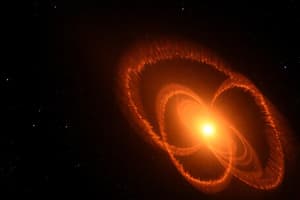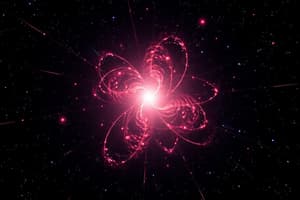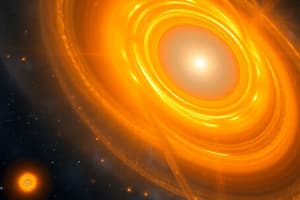Podcast
Questions and Answers
What was the primary role of the radio telescopes designed and built by Jocelyn Bell Burnell and Antony Hewish?
What was the primary role of the radio telescopes designed and built by Jocelyn Bell Burnell and Antony Hewish?
- To measure the gravitational waves emitted by neutron stars.
- To transmit high-energy cosmic radiation into deep space.
- To detect and analyze quasars, a newly discovered form of high-energy cosmic radiation. (correct)
- To study the atmospheric conditions of distant planets.
Why did Jocelyn Bell Burnell initially refer to the first detected pulsar signals as 'LGM-1'?
Why did Jocelyn Bell Burnell initially refer to the first detected pulsar signals as 'LGM-1'?
- It was an acronym for a complex mathematical equation used to analyze the signals.
- She playfully considered the possibility that the signals could be from extraterrestrial intelligence. (correct)
- It was a code name to keep the discovery secret from other researchers.
- It was a designation indicating the signal's location in the Large Magellanic Cloud.
How did Tak Wah Mak's research contribute to the understanding and treatment of cancer?
How did Tak Wah Mak's research contribute to the understanding and treatment of cancer?
- He discovered the genetic encoding of human T-cell receptors and identified a chemical to block the fuel supply of Hodgkin's lymphoma. (correct)
- He pioneered the use of stem cell transplants to regenerate damaged tissues in cancer patients.
- He invented a new form of radiation therapy that selectively targets cancer cells.
- He developed a revolutionary surgical technique for removing cancerous tumors.
What fundamental aspect of the body's immune system did Tak Wah Mak's research elucidate?
What fundamental aspect of the body's immune system did Tak Wah Mak's research elucidate?
What was the key conclusion drawn by Bell Burnell and Hewish regarding the origin of the pulsating radio waves they detected?
What was the key conclusion drawn by Bell Burnell and Hewish regarding the origin of the pulsating radio waves they detected?
How did Jocelyn Bell Burnell's early education influence her career path in physics and astronomy?
How did Jocelyn Bell Burnell's early education influence her career path in physics and astronomy?
In what specific way did Tak Wah Mak utilize experiments with mice in his genetic research?
In what specific way did Tak Wah Mak utilize experiments with mice in his genetic research?
What was the significance of Jocelyn Bell Burnell not being named in the Nobel Prize awarded for the discovery of pulsars?
What was the significance of Jocelyn Bell Burnell not being named in the Nobel Prize awarded for the discovery of pulsars?
Flashcards
Jocelyn Bell Burnell
Jocelyn Bell Burnell
First scientist to detect pulsars as a postgraduate student.
Pulsar
Pulsar
Rapidly rotating, strongly magnetized neutron star that emits pulses of radiation.
LGM-1
LGM-1
Initial playful name for pulsars before the term was officially coined.
Tak Wah Mak
Tak Wah Mak
Signup and view all the flashcards
T-cells
T-cells
Signup and view all the flashcards
Antigens
Antigens
Signup and view all the flashcards
Unexpected signals
Unexpected signals
Signup and view all the flashcards
Antony Hewish
Antony Hewish
Signup and view all the flashcards
Study Notes
- The text provides information on the scientific contributions of Jocelyn Bell Burnell and Tak Wah Mak
Jocelyn Bell Burnell
- As a postgraduate student, Bell Burnell was the first scientist to detect pulsars.
- This discovery opened a new branch of astrophysics.
- In her teenage years, she decided to work in astronomy.
- Bell Burnell began a PhD thesis on twinkling quasars at Cambridge University in 1965 after graduating from Glasgow University.
- She helped design and build an array of radio telescopes under the supervision of Antony Hewish to detect quasars.
- In November 1967, her instruments detected radio waves pulsating every 1.337 seconds from a fixed point in space.
- Similar signals were detected in other parts of space over the following 2 months.
- Bell Burnell and Hewish determined that the radio waves came from the radiation beam of a rapidly rotating, strongly magnetized neutron star.
- Each rotation emitted a "pulse," thus the name "pulsar".
- Bell Burnell initially referred to the radio waves as LGM-1 (Little Green Men-1).
- Her supervisor Antony Hewish received the Nobel Prize in Physics in 1974.
- Bell Burnell was made a Dame Commander of the British Empire (DBE) in 2007 for her services to astronomy.
Tak Wah Mak
- Mak discovered how T-cells recognize antigens.
- Mak advanced molecular knowledge of cancer cells.
- Mak was born in southern China in 1946.
- He studied at the University of Wisconsin and gained a PhD in biochemistry at the University of Alberta, Canada, in 1968.
- In 1972, he accepted a fellowship at the Ontario Cancer Institute after completing his doctorate.
- Mak's research focused on T-cells, white blood cells produced by the thymus gland.
- In 1983, Mak discovered that the genes of T-cell receptors used for antigen recognition have a unique genetic sequence and origin.
- In March 1984, Mak detailed the genetic encoding of human T-cell receptors in Nature journal.
- In 1988, he used experiments with mice to isolate genetic function for cancer and immunology studies.
- In 1999, Mak identified a chemical to block the fuel supply of Hodgkin's lymphoma.
Studying That Suits You
Use AI to generate personalized quizzes and flashcards to suit your learning preferences.
Description
Jocelyn Bell Burnell, as a postgraduate student, detected pulsars, opening a new branch of astrophysics. Working with Antony Hewish, she helped design radio telescopes and discovered radio waves pulsating every 1.337 seconds from a fixed point, identifying them as radiation from a neutron star.





